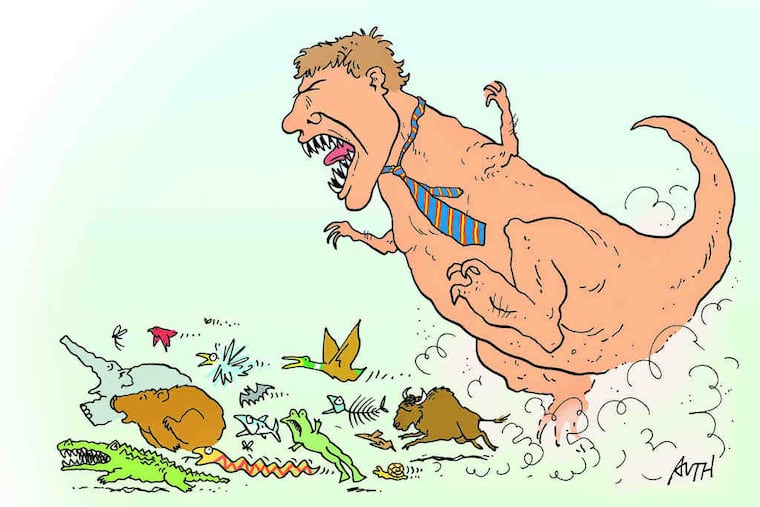Accelerated extinction
History's normal rate of species disappearance is quite slow. That's changing, and Haiti is a sobering microcosm of the problem.

Biologist E.O. Wilson once pondered whether many of our fellow living things were doomed once evolution gave rise to an intelligent, technological creature that also happened to be a rapacious carnivore, fiercely territorial, and prone to short-term thinking.
We humans can be so destructive that some scientists believe we've now triggered a mass extinction - one that in several hundred years will rival the asteroid impact that killed the dinosaurs.
In some places, a mass extinction is already under way. Haiti, a "hotspot" for plant and animal diversity, may be closest to ecological collapse.
The geologic record shows the living world went through five previous spasms of extinction in the last 500 million years.
There's plenty of evidence that the sixth mass extinction has begun, said biologist Stuart Pimm, chair of conservation ecology at Duke University.
"We are clearly living in an era where we're driving species to extinction 100 to 10,000 times faster than they should be going extinct," he said.
There's a wide range in those numbers because the fossil record shows just a fraction of what lived in the past, and scientists don't know exactly how many species exist today.
From what they can tell, said Pimm, the normal "background" level is quite slow. His estimate: About one bird species disappears per century and one amphibian every 150 years.
Now, he said, "species are going extinct every year."
We don't know exactly how many we're losing because we don't know even a fraction of all the species that exist. "We have a remarkably incomplete inventory of life," said University of Chicago paleontologist David Jablonski. "There are plenty of species that have gone extinct before they were ever discovered."
It's not that scientists are lazy, he said, but that there are a staggering number of species of insects, amphibians, birds, plants, and other living things, especially in tropical areas.
One way they can estimate current extinction rates is through sampling, said Duke's Pimm. By studying well-known animals, such as birds, scientists can infer the extinction rates of lesser-known ones.
Others are focusing more regionally. In Haiti, it's clear there's a mass extinction going on, said Pennsylvania State University biologist Blair Hedges. The country, which occupies the western part of the Caribbean island Hispaniola, is still reeling from the massive earthquake in January 2010. Over the years, it has lost 99 percent of its forest, once home to a great diversity of plants, birds, reptiles, and amphibians.
While many of the birds also live on the other side of the island, in the Dominican Republic, Haiti has a number of frog species unique to that country.
And of the 50 frogs endemic to Haiti, 49 are endangered, said Hedges, who is leading an expedition this week to several remote, mountainous areas of the country in an attempt to capture a few of these rare frogs.
Some Haitian frogs already live at the Philadelphia Zoo. The frogs brought back from this expedition may be taken to breeding programs at other zoos as well, where they can be appreciated and studied even if they disappear in the wild.
Fossil frogs have been found dating to the Jurassic period, showing that these creatures have been leaping around for at least 200 million years. That means they somehow adapted to whatever killed the dinosaurs. And yet now, they're dying off worldwide.
Some of those deaths have been attributed to an infectious fungus, spread by an African clawed frog that was removed from its native habitat and sent around the world for use in pregnancy tests (hormones in a pregnant woman's urine would cause these frogs to produce sperm or eggs).
But many believe the pregnancy-test frog is just one factor among several that are behind the dying.
In Haiti in particular, the rapid clearing of forests threatens to kill them much faster than the fungus could, said Penn State's Hedges.
His hope is that people will recognize how important it is to save that last 1 percent of Haiti's forest, not just for the frogs, but for the humans as well.
Most Haitians depend on the wood for cooking fuel. If they run out of wood before anyone comes up with an alternative cooking system, there will be massive famine.
Hedges and other biologists agree that Haiti shows us an example of what could happen elsewhere, a microcosm of the current mass extinction that's just beginning.
"This is basically a symptom of a much larger issue," said Thomas Lovejoy, a conservation biologist and past president of the Heinz Center for Science, Economics, and the Environment. "I've heard other people say that Haiti is the unthinkable experiment that no scientist would be allowed to conduct."
Are there any lessons from the last five mass extinctions? "One of the take-home messages is that they can happen," said Chicago's Jablonski. "You can push big ecosystems of the world beyond their breaking point."
The event that killed the dinosaurs 65 million years ago cleared out 75 percent of all species on the planet. An even more deadly event happened around 251 million years ago, ending the Permian period. More than 90 percent of the world's species perished.
The aftermath of such events is like a lottery, Jablonski said, with winners and losers that are hard to predict. These events usually lead to regime changes, where dominant life forms die off to be replaced by something else.
Who wins and who loses won't be known for some time. It takes 5 million to 10 million years for the biosphere to recover its diversity - and it's never the same.